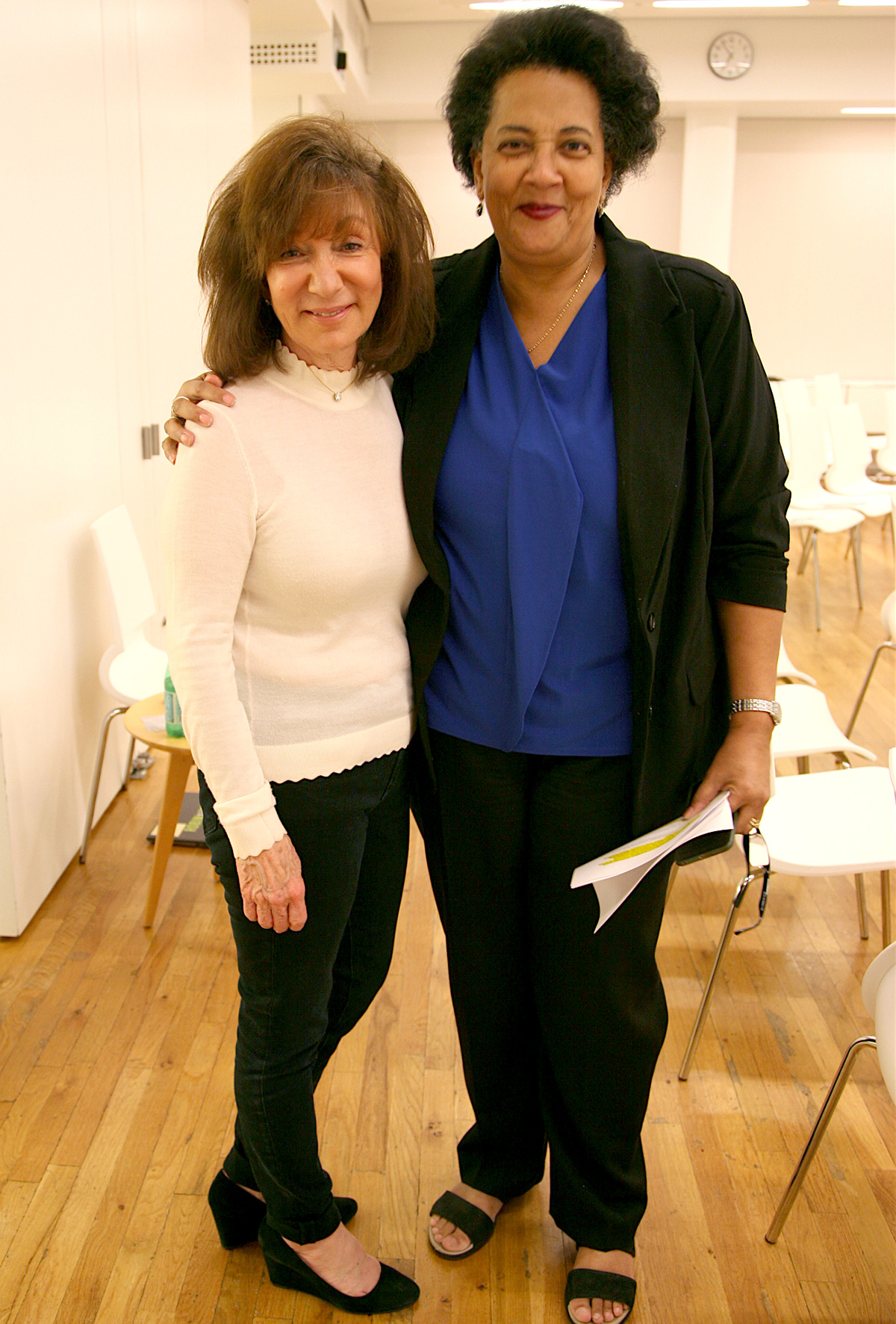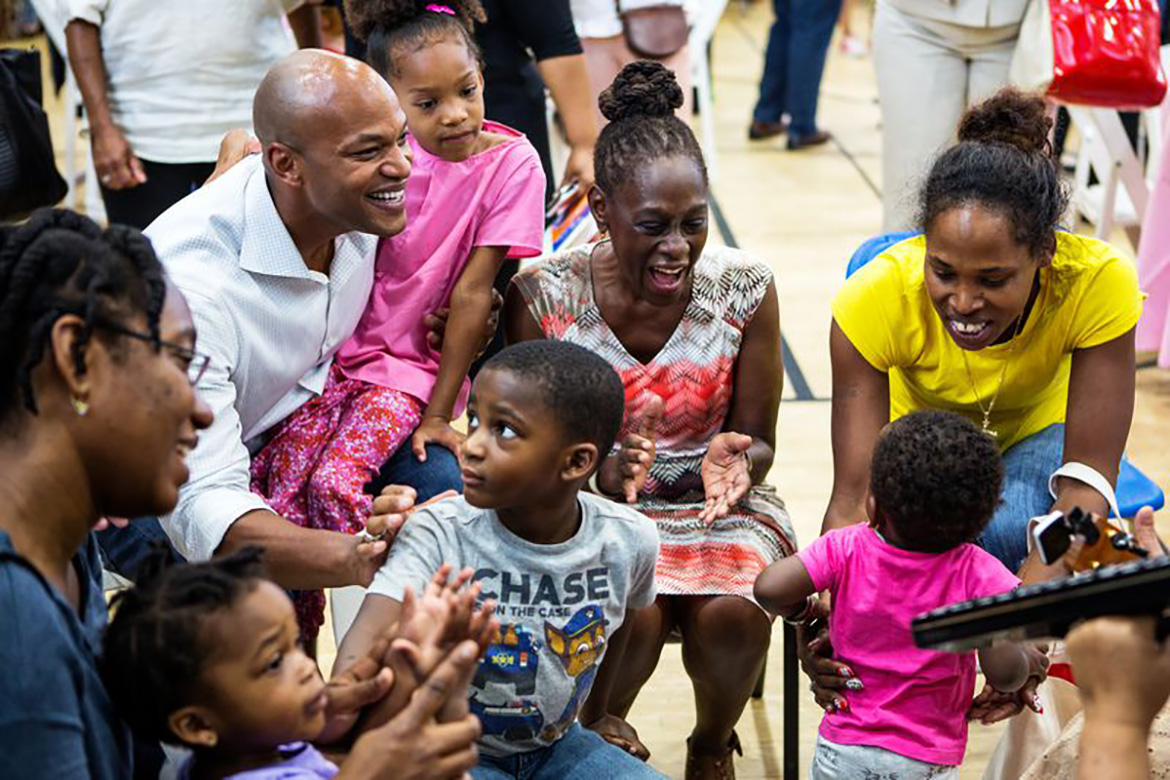Featured photo caption: Wes Moore, CEO of Robin Hood, with Chirlane McCray, First Lady of New York City, at the FUEL launch event at the Brownsville Recreation Center in Brooklyn. Photograph courtesy Office of the First Lady, New York City.
The greatest city in the world. More than 100,000 children 0-3 growing up in poverty. Two facts that are painful to reconcile.
This is a job for Robin Hood. Unafraid to challenge the seemingly intractable, the grant maker and all-around poverty fighter combines rigorous data and strategic partnerships with powerhouse fundraising.
Here’s the story behind the $50 million, five-year Fund for Early Learning (FUEL) .
The Beginnings of FUEL

Jackie Bezos had a bold vision: to build the nation’s first Early Learning Metropolis where parents in low-income communities can provide the best start for their children. This mandate became the rallying cry of the 2016 Robin Hood Annual Benefit. After a musical set by Usher, guests made generous pledges to fuel FUEL.
Robin Hood, a torchbearer for bringing people together to solve big problems, led with science by creating a brain trust. It consulted with 80+ leaders in related research fields. It also worked closely with Jackie Bezos, a Robin Hood board member, chair of the Early Childhood committee and President of the Bezos Family Foundation; John Overdeck, a Robin Hood board member and Co-chairman and Co-founder of Two Sigma Investments, LP; and several other lead funders: the Touradi Family Foundation, the Heising-Simons Foundation and the Einhorn Family Charitable Trust.
The next step was a partnership with the Children’s Cabinet, a multi-agency initiative created by Mayor De Blasio to bolster communication and coordination among the city’s child-facing agencies, and to provide a space to identify and analyze individual and common areas of work that affect child safety and well-being.
FUEL now comprises 18 partners representing the capacity to reach over 50,000 families with infants and toddlers by the end of FUEL’s five-year time horizon. Pilot programs undertaken in preparation for scaling to date have already increased the number of children served by Robin Hood-supported early childhood programs 5-fold, from 1,200 children a year to 6,000 children.
Partnering with city government was a somewhat controversial idea, because people feared that red tape would slow progress. But the City can also reach scale and embed good practices into its signature work.
Deborah McCoy, Robin Hood’s Managing Director of the Early Childhood & Youth portfolio, says, “We believe a partnership with the City can provide legacy for the effort because FUEL is a five-year fund; it will sunset. But we don’t want the efforts to end. Rather, we want people to have bought into them sufficiently so that they become part of their own ongoing agenda and a way of doing business with families with very young children.”
One example is Robin Hood’s Babies in Shelters project. While the mandate in shelters is to get people into permanent housing, babies are being born in shelters and living their first 400 days, on average, in shelters in highly adverse circumstances, which themselves have long-term, damaging consequences. Robin Hood experimented with a multi-faceted approach that encourages maximum and ultimate—ultimate—impact to proved concepts, collect data and ensure solutions are portable into different contexts.
Dr. Kelvin Chan, Director of FUEL, says, “In many ways, we’re setting up programs to have lives of their own, that are built on the backbone of science to be consistent with early brain development, that are funded by way of City administrative funding. The focus on sustainable solutions is really key here. One strategy is to steer base-lined, tax-levied, funded programming into the direction of evidenced-based programming that will drive positive child outcomes. Our aim is that FUEL will fundamentally change how the City will operate.”
The Three-Tiered Approach
McCoy says, “These babies and parents need effective, evidence-based services so those precious moments of brain development won’t be squandered. We took that proposition to the City government and are now partnering with them.
- New York City. There are many systems that interact with parents in less than optimal ways. How can our work improve those interactions
- There’s a community strand, a collective action strand, to the work. Our inaugural efforts are in the South Bronx and Brownsville, Brooklyn, two high poverty districts, both with collective action coalitions aimed at closing achievement gaps for all children, “cradle to career.”
- Community-based organizations. How can they be recruited to partner on the more individual, intervention-oriented kinds of things? Can we, for example, successfully incubate a low-cost but effective and scalable intervention to be incorporated in a community-based organization, as we have done with Filming Interactions for Nurture Development (FIND), created by Dr. Phil Fisher at the University of Oregon or with Routine Language, created by Dr. Catherine Tamis-Lemonda at NYU.
On top of funding, Robin Hood provides technical assistance for each community partner so they’re aligned with the neuroscience of early brain development in their respective programs. Robin Hood also encourages partners to operate with a built-in lens of early-childhood development.
When asked what Robin Hood most wants people to know about FUEL, Chan says, “I think it should be known as, in essence, an incubation chamber for novel concepts and practical solutions for brain development. We’re building a diverse portfolio that allows us to lay out the work for prospective investors to understand how we navigated a complex system to find solutions. And to share what we’ve learned.”
“In many ways,” Chan continues, “FUEL also should be seen as a benchmark of sorts for early childhood. This is a rare opportunity to see how different investments pan out over time. Being that archetype and reference point for future practices is what we want people to take away.”
It’s not unusual for other cities to follow Robin Hood’s lead. One reason why Robin Hood has such success with ambitious partnerships is its strong relationships. Can Robin Hood serve as an example to other cities that might not have the strength of those relationships?
McCoy explains: “It’s true that Robin Hood is a known quantity and a desirable funder because of how we fund and how we partner. But in the absence of this kind of entity, or other leverage points, in other jurisdictions, you’ll often find a champion in the Governor’s office or Mayor’s office who can spearhead an effort, which can take on the challenge.”
“As we go forward,” Chan reveals, “We hope to announce more state partnerships. That will be the product of some of those barriers being slightly knocked down, lowered a little bit, so that we have that movement and opportunity to fundamentally change their outlook and their work with children, and the families of the infants and toddlers. Then, that work can be maximized to generate those outcomes that are so important to the success of kids living in poverty.”
What does success for FUEL look like? Chan says, “Success means that we have sustainable solutions that are permanently in place to bolster the brain development of children living in poverty. Success also means that we have learned from our mistakes. Success certainly means that we have built a very strong network of public-private partnerships that can be regarded as a way to build, or to defragment, a system for 0-to-3-year-olds anywhere.”
The field of brain science shows us that children are wired to learn from birth. In fact, this early developmental stage is the most critical to a child’s trajectory and lifetime outcome. Truly: one million new neural connections form every second during this period of a child’s life.
Science also shows how parents, grandparents, teachers, doctors and caregivers play a critical part in building those brains in everyday moments.
FUEL shares this science with grantees and translates the science into actionable interventions. It also teaches organizations how to train caregivers because the real opportunity is to create a model. Cities across the country watch what Robin Hood does in New York, as do the state and federal governments, and even beyond the nation. While Robin Hood’s mission is to fight poverty in New York City, this effort to create the nation’s first Early Learning Metropolis is helping inform the field and fuel the future of children everywhere.
Linda Shockley is a New York-based writer, and communications specialist for the Bezos Family Foundation.



